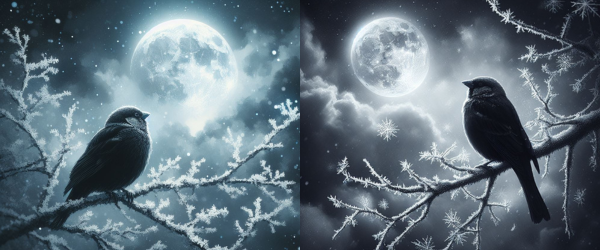Once upon a frosty morning, a peculiar sparrow perched on a frost-kissed branch in the heart of a secluded forest. Its feathers were not the usual shades of brown or gray; instead, they shimmered like the midnight sky, a deep black that seemed to absorb the very essence of light. This was no ordinary sparrow it was a sparrow frost black.
The Enigma of Sparrow Frost Black
Unraveling the Mystery
The sparrow frost black is not a distinct species but a rare color variation found among several species, including the House Sparrow (Passer domesticus) and the Tree Sparrow (Passer montanus). Unlike their more common counterparts, these avian anomalies exhibit a genetic mutation that leads to an overproduction of melanin, resulting in their striking black pigmentation.
A Closer Look
Let’s delve into the details:
- Black as Night: The plumage of the sparrow frost black is as dark as a moonless winter night. Each feather absorbs and reflects light in a way that defies the ordinary. Imagine a tiny creature flitting through the frost-laden branches, its ebony wings catching the first rays of dawn.
- Frost Kissed Edges: The frosty touch is not merely symbolic. The edges of their feathers bear delicate frost-like patterns as if Jack Frost had traced intricate designs upon them. These icy accents add to their mystique.
- Maestro of Silence: The sparrow frost black is a master of stealth. Its ebony plumage allows it to blend seamlessly into the shadowy underbrush. It moves silently, a phantom among the leaves, leaving no trace of its passage.
The Quest for Understanding
Scientists and bird enthusiasts alike are captivated by this enigmatic creature. Questions abound, How does the genetic mutation affect their survival? Do they face challenges in finding mates? And what role does their unique appearance play in their ecosystem?
Scientific Name of Sparrow Frost Black
The scientific name for the captivating sparrow frost black is Passer domesticus (House Sparrow) or Passer montanus (Tree Sparrow), depending on the specific species. With their midnight-black plumage and frost kissed edges, these remarkable birds continue to intrigue scientists and bird enthusiasts alike.
How Rare Are They?
The sparrow frost black is an infrequent phenomenon. Encountering one in the wild is akin to stumbling upon a hidden treasure a fleeting moment that leaves an indelible mark on the observer’s memory. These enigmatic birds defy the ordinary, their ebony plumage starkly contrasting with their more common counterparts’ muted browns and grays.
In terms of statistical rarity, precise numbers are elusive. Ornithologists estimate that only a minute fraction of sparrow populations exhibit this striking color variation. Imagine a vast forest teeming with sparrows, and then consider how few among them bear the frost kissed blackness. It’s akin to finding a needle in a haystack or, perhaps more fittingly, a single obsidian gem amidst a sea of pebbles.
Why are they so scarce? The answer lies in their genetic makeup. The mutation responsible for their unique appearance occurs sporadically, a cosmic roll of the dice that grants them their otherworldly allure. Survival in the wild is a challenging feat for these avian anomalies. Their ebony plumage makes them stand out both a blessing and a curse. While it aids in stealth during moonlit nights, it also attracts the attention of predators.
As we ponder the rarity of the sparrow frost black, let us marvel at the delicate balance of nature. No matter how uncommon, each creature plays a role in the intricate tapestry of life. The rarity lends them an air of mystique, a reminder that magic exists even in the mundane.
So, dear reader, keep your eyes peeled during frost kissed mornings. Who knows? You might glimpse the fleeting silhouette of a sparrow frost black, a living testament to nature’s artistry.
Habitat of Sparrow Frost Black
The sparrow frost black thrives in various habitats, each contributing to its captivating allure. Let us explore these realms where the ebony winged enigma dances between light and shadow:
1. Arid Brush and Desert Flats:
-
- These frost kissed sparrows find solace in arid landscapes. From the Sonoran desert, adorned with a mix of shrubs and cacti, to the barren flats of creosote bush and saltbush, they navigate the harsh terrain with grace.
2. Wooded Edges and Streamside Thickets:
-
- Amidst wooded areas and undergrowth, the sparrow frost black weaves its way through life. Breeding in brushy habitats, including woodland edges, clearings, and streamside thickets, it leaves its mark on the quiet corners of the forest.
3- Pinyon Juniper Woods and Coastal Forests:
-
- These elusive birds flit among the branches in open pinyon-juniper woods, where the scent of resin hangs in the air. And occasionally, they venture into stunted coastal forests, their ebony plumage a stark contrast against the greenery.
4. Frosted Tundras and Hidden Beauty:
-
- Imagine embarking on a physical expedition, tracing the trail of the black sparrow across a frosted tundra. Here, the Sparrow Frost Black becomes a guide, leading us through treacherous landscapes, testing our resilience, and revealing the hidden beauty of a harsh environment.
Few spectacles rival the sizing contrast showcased by the Sparrow Frost Black in the vast canvas of nature’s palette. It is a living testament to the delicate balance of existence a reminder that magic exists even in the mundane.
How Do They Survive in Winter?
With its midnight plumage and frost kissed edges, the sparrow frost black navigates the harsh winter with remarkable adaptations. Let us unravel the secrets of its survival:
1. Insulating Feathers:
-
- The sparrow fluffs its feathers like a cozy blanket when the cold winds bite. This ingenious adaptation creates insulation, trapping warm air close to its body. The frost kissed edges of its plumage add an extra layer of protection against the chill.
2. Communal Warmth:
-
- These birds are social creatures. During winter, they huddle together in tight knit groups, sharing body heat. The collective warmth generated by their proximity helps them brave the frosty nights. Imagine a cluster of ebony-feathered sparrows, their breath visible in the crisp air as they weather the cold as one.
3. Strategic Shelter:
-
- Non-migratory sparrows seek out warm, sheltered areas. Whether it’s cozy nooks in dense shrubbery, well-vegetated suburbs, or even urban parks, they find refuge from biting winds and freezing temperatures. Their distinctive black and white head stripes stand out, a testament to their resilience in the face of winter’s challenges.
4. Nature’s Artistry:
-
- The very existence of the sparrow frost black is a testament to nature’s artistry. It thrives where frost meets shadow, where darkness and light collide. As the world slumbers under a blanket of snow, these enigmatic birds continue their silent dance a reminder that survival is science and magic.
So, next time you glimpse a sparrow flitting through frost laden branches, remember the hidden adaptations that allow it to thrive in winter’s icy embrace.
Other Birds with Similar Mutations
Indeed, the sparrow frost black is not the sole avian marvel. Other captivating mutations and adaptations have arisen across the vast tapestry of bird species. Let us explore a few:
1. Violet Pied Lovebirds:
-
- These lovebirds exhibit a delightful combination of violet and pied mutations. Their plumage showcases patches of violet and white, creating a striking contrast. Imagine a lovebird with a painter’s palette, dabbing hues onto its feathers.
2. Lutinos:
-
- Lutinos are lovebirds with bright yellow bodies adorned with orange-to-red facial markings and striking red eyes. Their vibrant appearance stands out against the green foliage, a burst of sunshine in avian form.
3. Black Chinned Hummingbird:
-
- While not a sparrow, the black-chinned hummingbird (Archilochus alexandri) deserves mention. It boasts the smallest genome among birds, a mere 0.91 gigabases long. These tiny aerial acrobats flit through gardens, their iridescent plumage shimmering like liquid jewels2.
4. Flightless Birds and Regulatory Pathways:
-
- Flightless birds, such as the extinct moa, have undergone fascinating genomic changes. Despite diverse protein coding portions, they converge on similar regulatory pathways when evolving flight loss. Nature’s tinkering with their genetic switches has led to their grounded existence.
5. High-Altitude Birds and Hemoglobin Adaptations:
-
- High-altitude birds, including birds of prey and songbirds, have evolved similar traits via different mutations. Notably, their hemoglobin better at capturing and distributing scarce oxygen—has adapted to the thin air of lofty plateaus. These feathered mountaineers defy the odds, each species finding its unique path to survival.
So, as we marvel at the sparrow frost black, let us remember that the avian world is a canvas of diversity, painted with mutations, adaptations, and wonders waiting to be discovered.
Conservation Efforts for Them
Conservation efforts for the sparrow frost black are as delicate and intricate as the bird. Let us delve into how humanity strives to protect this enigmatic creature:
1. Habitat Preservation:
-
- The first line of defense is safeguarding their natural habitats. Conservationists work tirelessly to protect woodlands, brushy areas, and streamside thickets the landscapes where these ebony-winged sparrows thrive. By preserving these ecosystems, we ensure the sparrow frost black has a sanctuary to call home.
2. Genetic Studies and Monitoring:
-
- Scientists conduct genetic studies to understand the mutation responsible for their unique appearance. By unraveling the intricacies of their DNA, we gain insights into their survival mechanisms. Regular monitoring helps track their populations, assess threats, and adapt conservation strategies.
3. Awareness Campaigns:
-
- Educating the public about the rarity and significance of the sparrow frost black is crucial. Awareness campaigns raise eyebrows and binoculars alike. When people recognize the value of these avian anomalies, they become stewards of their habitats.
4. Urban Planning and Green Spaces:
-
- Even in bustling cities, pockets of greenery matter. Urban planning incorporating green spaces—parks, gardens, and tree-lined streets—provides refuge for these birds. Rooftop gardens and community-led initiatives contribute to their survival.
5. Mitigating Climate Change:
-
- The frost-kissed edges of their plumage are a testament to their adaptation to cold climates. As global temperatures rise, we must combat climate change to prevent habitat loss and extreme weather events that threaten their existence.
6. Collaboration Across Borders:
-
- The sparrow frost black knows no borders. International collaboration ensures that conservation efforts span across countries. Joint research, habitat restoration, and coordinated action are essential.
When frost glistens on branches in the quiet moments of dawn, let us remember the sparrow frost black a living paradox of darkness and light. As we weave our conservation tapestry, may it be embroidered with hope, resilience, and the promise of a future where these birds continue to dance through our forests.
Conclusion: A Call to Curiosity
As we explore the sparrow frost black, let us ponder: What other hidden wonders lie within the natural world? Perhaps more secrets are waiting to be unveiled in the quiet corners of our forests and meadows. So, dear reader, I leave you with this question: What other mysteries await our curious gaze?





